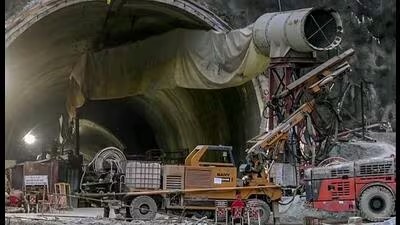
Rat Hole Mining

29.11.2023
Rat Hole Mining , Daily Current Affairs , RACE IAS : Best IAS Coaching in Lucknow
|
For Prelims:About Rat-Hole Mining,Types of Rat Hole Mining: For Mains Paper:Why ban on rat-hole mining, |
Why in news:
Rat hole mining is being done to save workers in the collapsed Silkyara-Barkot tunnel in Uttarakhand.
Important points:
- The practice of rat-hole mining has been banned by the National Green Tribunal.
- Rat-hole mining was felt after the failure of an American auger drilling machine in the Uttarakhand rescue operation.
- Officials involved in the rescue operation said horizontal drilling through the last 10-12 meters of debris of the collapsed part of the tunnel has to be done manually by a team of six rat-hole miners from Madhya Pradesh.
About Rat-Hole Mining:
- Rat-hole mining is a primitive and dangerous method.
- Rat-hole mining is a primitive and dangerous method of coal extraction in India, especially in the northeastern state of Meghalaya.
- The term "rat-hole" refers to narrow pits dug in the ground, usually just large enough for a person to climb down and extract coal.
- Miners use ropes or bamboo ladders to reach coal seams, extracting coal manually with tools such as picks, shovels, and baskets.
- Due to the small size of the tunnels, these miners, who sometimes include women and children, crawl through these tight spaces on their knees while using picks to extract coal.
Types of Rat Hole Mining:
There are 2 types of rat hole mining.
Side Cutting:
- In the side-cutting method, workers excavate narrow tunnels along hill slopes, moving inward until they find a thin layer of coal, which in most cases is less than 2 meters in the hills of Meghalaya.
Box Cutting:
- In the box-cutting approach, a rectangular opening ranging from 10 to 100 square meters is created.
- Next, a vertical pit is dug, reaching a depth of 100 to 400 feet.
- Upon identifying a coal seam, small tunnels the size of rat holes are dug horizontally, allowing workers to extract the coal.
Ban on Rat Hole Mining:
- The National Green Tribunal (NGT) banned rat-hole mining in 2014, citing concerns about its unscientific nature and the safety risks posed to workers.
- However, in 2019, the Supreme Court struck down the NGT's ban and allowed coal mining in Meghalaya through scientific mining methods.
Why ban on rat-hole mining:
- This process is not only dangerous for the miners but also harmful for the environment.
- Rat-hole mining has been linked to many ecological issues, such as acidification of rivers, deforestation, soil erosion and disruption of local ecosystems.
- Acidic runoff from these mines, known as acid mine drainage (AMD), is particularly harmful, degrading water quality and reducing biodiversity in the affected water bodies.
This pollution has extended beyond the borders of India, affecting the rivers flowing in Bangladesh.